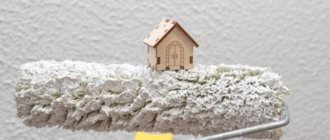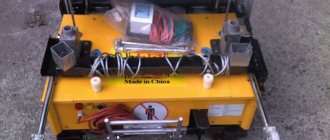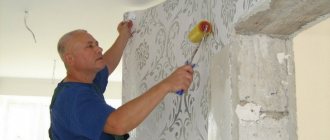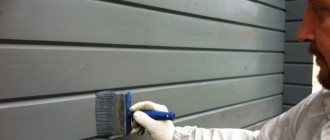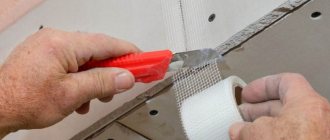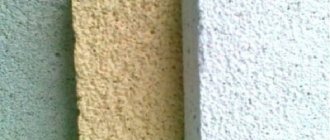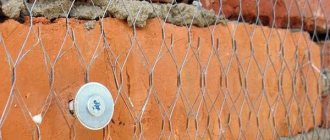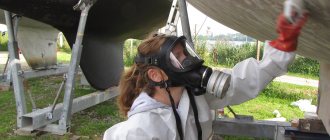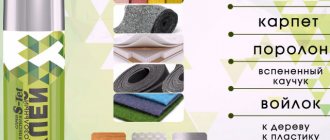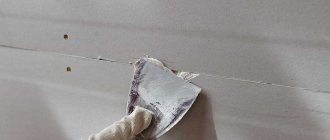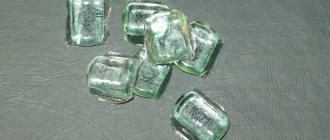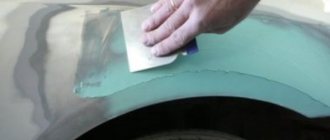Recently, names of finishing materials such as microconcrete and decorative microcement plaster have often been encountered. The material was invented by the developers of a company from Argentina – Edfan (the brand’s products are represented in Russia). The new product has already been appreciated, and I would like to tell you more about it (as an alternative to self-leveling floors and ceramic tiles).
Microcement and microconcrete what is it?
The composition of the material is reflected in the name itself. The developers set a goal to create a finishing material for walls under heavy load that would be distinguished by both strength and fineness of the grains of the binder and filler, therefore, especially finely ground cement (up to grains of 6-8 microns) was used as a binder. Quartz sand is also distinguished by its small grain diameter, allowing the application of layers of minimal thickness (two layers in total do not exceed 3 mm). The new material has two varieties, differing in grinding thickness. A rougher coating is called microconcrete, another (close to Venetian in terms of thinness and smoothness of the surface) is called microcement decorative plaster.
In addition to fine-grained (almost flour) quartz filler and finely ground cement, the composition includes pigments and polymer additives. Thus, the new product is both an industrial and decorative material, creating a texture as close as possible to concrete, differing from it in being visually more pleasing to the eye, and not causing discomfort to bare walls.
The use of microconcrete is wider than that of decorative compositions. They strengthen the soil and are used in well repair and underground construction. In housing, industrial and public buildings, microconcrete is successfully used for flooring. In general, the material successfully covers any solid base, it can be reinforced and used in a heated floor system.
The new material is used for furniture decor and floor coverings, which allows you to create interiors in a single style.
Microcement plaster is classified as a premium material, and its price is set according to this level. In terms of wear resistance and strength, for example, impact, micro-concrete and micro-cement coatings are superior to laminate, ceramic tiles, parquet boards or marble. For this reason, it is more readily used for flooring, where, apart from porcelain stoneware and floor tiles, microconcrete has no competitors. Microcement compounds are also used for finishing furniture, for example, countertops.
Microcement has a decorative value - water stains, more noticeable on dark-colored material. Thanks to stains, the coating takes on a natural look.
In addition to the composition features, the new product is distinguished by the unique technology on which the success of the coating depends. Therefore, it is necessary to learn how to apply microcement mass. Application is by hand only.
Advantages and disadvantages
Let us dwell on the positive and negative features of the material.
In addition to visual “pleasantness,” the new material has attractive properties:
- surprisingly strong adhesion (even with materials such as glass, ceramics, wood, plastic, metal) is achieved due to the ability of the solution to penetrate into the smallest pores of the base and the stickiness of the cement-polymer components;
- high strength (successfully resists abrasion, compression, even has a certain bending strength) both due to binders and due to an increase in the total surface of inert particles;
- waterproofness and resistance to water (achieved due to the density of the particles and the water-repellent properties of the resins);
- versatility (suitable for facades and interiors);
- the possibility of applying very thin coatings (for example, when redecorating floors, a thin layer will not require lifting the door blocks);
- fire safety and resistance to heat (however, dishes removed from the fire cannot be placed on the coating);
- high decorative capabilities (basic palette - from 30 colors, possibility of obtaining a glossy or matte surface, the material is highly plastic);
- durability;
- resistance to biodestruction;
- seamlessness;
- the ability to carry out finishing work indoors;
- lack of cooling sensation when touched;
- does not absorb odors;
- not afraid of vibrations;
- small thickness, superplasticity and adhesiveness make it possible to strengthen weak foundations;
- water-, vapor-tightness (allows use in areas of direct exposure to water);
- long service life;
- ease of care (washable with neutral products).
Types of microcement
There are two main types of microcement:
- one-component (mixed only with water), dehydrated acrylic resin is added to the composition in powder form (due to which it partially loses its properties);
- two-component (A – dry composition in powder form, B – liquid resin component).
There are several modifications of the microcement mixture in the lines of the main manufacturers.
For example, the Spanish company Topciment offers the following types of two-component microcement for decorative plaster:
- Microcement base - used mainly for applying a base layer under other types of microcement mixtures, gives a “lumpy” rough surface (can also be used for applying a top decorative layer). Consumption for two-layer coating per meter is 2.0 kg, grain size up to 0.5-0.6 mm.
- Microdeck is more suitable for floors of rooms, for example, stairs, corridors, where there is the most intense traffic. Consumption per meter square – 1.0 kg, granules up to 0.2-0.3 mm.
- Microfino is used for finishing ceilings and walls. The mixture forms a silky, pleasant surface and has a streaky effect. Consumption – 0.5 kg per meter square, granules – up to 0.125 mm.
- Microstone - the material is ideal for facade and other external surfaces (verandas, terraces, loggias). Grains up to 0.4 mm, consumption – 2.0 kg per square, forms an anti-slip coating.
- Aquaciment M, XL is used for the base (first) and finishing layers of pool coatings (category M is for outer edges). It has an anti-slip effect (category XL - for internal surfaces) and smoothness. Consumption 3.0 and 1.8 kg/m2, respectively.
Application of microcement
Microcement does not require prior removal of tiles, even smooth ones, and can be applied over them. Therefore, energy and time for repairs are saved.
Surface preparation
Preparation of the base (floor and walls) may vary slightly. So for the floor (and steps of stairs) it is necessary to use high-quality material for the underlying screeds, strengthening the base surface, and reinforcing the edges of the steps. In general, the prepared surface should be strong, smooth, and free of cracks and differences in height of more than 2 mm. It must also be cleaned of stains, dust, and rusting objects. Before applying the microcement composition, the base is primed and dried twice.
Concrete, cement, stone or brick are moistened before application. Tiles, porcelain tiles, and laminated surfaces are degreased and cleaned. Drywall, chipboard and other similar substrates are primed with penetrating compounds containing sand.
Floor coating
Microconcrete is applied to the floors in three layers and the first of them must be reinforced. The diagram looks like this:
- 1st layer - alkali-resistant reinforcing mesh + base microconcrete + polymer;
- 2nd and 3rd layers - decorative microconcrete color + polymer.
Application technology for walls and ceilings
Walls and ceilings may not require reinforcement.
Application is similar to standard technology:
- the base layer is performed by continuous puttying of the surface “to tear off”;
- If the freshly applied mass loses its raw gloss, the finishing layer is smoothed with a metal trowel.
Smoothing can be either wet or dry, grinding with abrasives and polishing is allowed. If you want to create a rough texture, apply a pattern with a trowel. The final finishing is carried out by applying varnishes or special impregnations and wax.
Basic application technology:
- Surface preparation.
- Surface primer (quartz primer is most often used).
- Preparation of the solution: pour the liquid component into the container, mix it with the pigment (some dyes are diluted with water), add the dry mixture, mix with a mixer.
- Apply a thin base layer (1-2 mm) with a trowel.
- Use a sponge spatula (dry) to level the surface.
- The layer is smoothed again with a metal trowel, adding a slight pattern.
- After 2-3 hours (for tiles and Edfan mixtures - at least 24 hours), apply a second layer of 1-2 mm with a trowel.
- After about an hour, smooth the surface of the layer with a wet sponge.
- The khatem is smoothed again with a metal trowel, but not polished so that dark spots do not appear.
- At the finish (after 24 hours), the layer is sanded (can be done with a sander).
- Rinse thoroughly with water, wipe and leave for a day.
- Apply protective sealant to the plaster with a roller.
- After 12 hours, the application of varnish begins.
Finish wall covering
Dried walls are again treated with penetrating soil. The sprayer is not used in this case - it will cause drips that will harm the appearance of the finish.
After about 4 hours, finishing work begins. To carry them out, you need an optically transparent epoxy resin with a hardener in a ratio of 2:1. You don't need a large amount of resin: usually about 500 g of base and 250 g of hardener are enough. The components are mixed in a disposable plastic container.
Approximately 20 minutes after mixing, begin applying the resin to the walls in a thin layer. A small velor roller is best for this. After 48 hours, it is better to apply another coat of epoxy (the quality of the finish will be higher), although this is not necessary.
Advice! If epoxy resin is not available, you can use a two-component moisture-resistant varnish instead.
Popular manufacturers
A new material - microcement decorative plaster is produced not only by the developer, but also by a number of other companies. Among the most popular:
- Forza microcement from Goldshell is a durable decorative coating with the effect of “smooth and decorative concrete”. The dry mixture is sealed in a special binder and then varnished (at least two layers). Before varnishing, the surface is sanded with abrasive. Forza can be used in damp areas and applied over existing surfaces (tiles, laminate).
- Russian compositions Reamix are called two-component decorative putty. The composition requires purchasing two packages (dry mortar mixture + dry pigment that gives the solution the desired shade).
- Senideco Senibeton is a white material based on a polymer emulsion, completely ready for use, painted with liquid or dry pigment. It has three modifications according to grinding fineness (extra-fine, fine and coarse). The surface dries in 2 hours. The mixture is frost-resistant. Tinted with natural pigments (19 colors).
- Topciment is a manufacturer from Spain. The main mixtures are listed above.
- Stoopen&Meeus (Belgium, representative in Russia - “Marseille”) - a dry mixture that requires the addition of pigment. The lifespan of the prepared mass is 3-6 hours. Does not require preliminary priming of the base.
Art concrete - a new approach to decorative finishing
Despite popular belief, this term does not mean the type of finishing material, but the type of application. Art concrete is a decorative plaster used to create a visual effect: freshly poured formwork, mortar leaks, etc. The base material (one-component) can be almost anything: acrylic, lime.
Manufacturers of finishing materials add special additives to the dry mixture to impart certain properties (elasticity, rapid hardening and strength). Art concrete in the interior looks stylish, of course, provided that the application is carried out by a professional. When applied, one of the following textures is formed:
- mud hut;
- fan effect;
- holes;
- strokes.
In fact, to create a unique and beautiful texture, a finisher should be a bit of an artist, painting a unique picture. Art concrete is applied in 1-2 layers. The hardened surface is protected from above by impregnation.
If desired, the top layer can be made matte or shiny. The surface hardens completely after 3 days. After this, you can carry out wet cleaning and wash the plaster. For finishing you will need: primer, impregnation, art concrete, which can be purchased on our website expert-deco.ru.
What does the photo look like in the interior?
To get an idea of the wealth of effects obtained when using the new material, we suggest looking at a collection of photographs. Pay attention to the wealth of styles that cannot but attract designers.
Microcement is an excellent decorative plaster, suitable for covering countertops and decorating bathroom walls. The material allows you to obtain unique patterns, close to natural, with varying degrees of surface roughness. Unique strength combined with the thinness of the layer gives the new product advantages over traditional materials.
Required Tool
The selection of tools for applying decorative microcement plaster is determined by the viscosity of the material.
It cannot be applied using a tool that has a large working surface area, since it will be difficult to “pull” the material with acceptable evenness.
For work, it is most convenient to use a container that will fit the entire package - then you will not have to calculate the amount of sealer relative to the dry mixture. A mixer attachment for paint or putty is quite suitable for mixing.
